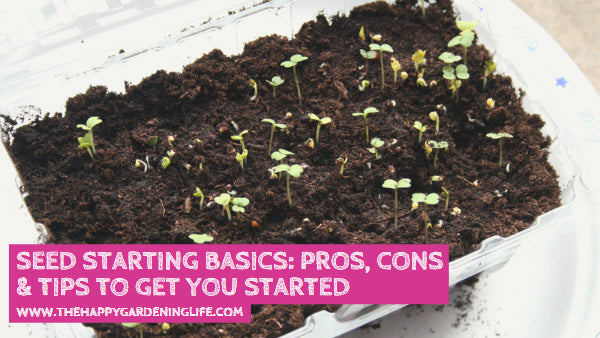
Seed Starting Basics: Pros, Cons & Tips to Get You Started
Share
 Wouldn’t it be great if you had a diverse range of vegetables in your own backyard?
Wouldn’t it be great if you had a diverse range of vegetables in your own backyard?
If you’re worried because you don’t know how to grow your own vegetables, don’t be! Because all of your fears of growing your own vegetables is now a thing of the past. It’s very easy to plant vegetables now.
All you need are some good vegetable seeds (depending on what type of vegetables you want to grow) and a bit of gardening knowledge.
Now, what are the advantages of growing vegetables right in your own backyard?
First is that you’ll have a much greater range of choices, and you won’t be limited by what’s available in your local markets. Having a variety of vegetables is always a plus because you can now prepare more diverse salads and enjoy more choices in food.
If you’re planning to grow your own veggies now, you must keep some things in mind. Most seeds require that the soil be at least 70° F. If that temperature is achieved, you will see your seedlings sprout up in just 5 days. Also, keep in mind the humidity levels as well as the lighting and supplemental nutrition for the seeds you plan to grow.
For more seed-starting tips, check out these basic guidelines below. Feel free to share this blog post with your gardening friends on Facebook and Twitter!
Why Start Your Own Seeds? What Pros and Cons are There?
1. You have a much greater range of choices on what to grow as you are not limited to what’s available at the local garden center, hardware store or Farmer’s Market.
2. There is greater flexibility on timing to get them started. You can start them to work with your schedule, or to take advantage of getting bigger, earlier producing plants in the garden sooner.
3. Starting your own seeds gives earlier veggies from the garden, as you start on your schedule, not depending on a regional greenhouse schedule. For example- here in AZ, most starts come from the central valley of CA, where timing is completely different, sometimes by a factor of several weeks.
4. Home gardeners can usually grow bigger, healthier plants than a commercial greenhouse, as there is more attention per plant. Less diseases/issues than from large scale grower. Seed starting does require some planning and effort, not as easy as going down and picking out what seedling to buy.
5. Does require some set up and equipment, but not much to get started. Will require some space, but not much on start-up.
6. Transplants give you a head start on weeds and the weather. A tomato or pepper that is 2 feet tall will have little to no competition from weeds that are just getting started.
Plan and Arrange the Seed Starting Area Ahead of Time
1. A key factor for successful germination is a warm area to sprout seeds- can be the top of a refrigerator, freezer, window sill in south-facing room, etc. When the temperature of the soil is optimum- seeds can and will “pop” in 5 days, no matter if they are tomatoes, peppers or eggplant! When the soil temperature is less than 70F, it can take 2 weeks to sprout- there is that much of a difference!
2. Supplemental heat may be needed. Soil temperatures need to be above 80F for faster germination. The ideal soil temperature for tomatoes, peppers and eggplant is 85F. Air temperature may be 5-10F different than soil temperature due to evaporative effects of moist soil. Heating pads, germination heat mats, old electric blankets, etc can work to raise soil temperature to where it needs to be. Monitor soil temperatures to avoid over-heating. A heat mat will work even if the air temperature is 60-65F.
3. Supplemental lighting may be needed after seeds sprout and develop true leaves. This can range from specific grow lights to common fluorescent fixtures with grow bulbs. Lights need to be moveable to keep about 2-4 inches above plants. Seedlings need 14-18 hours of light per day.
4. Humidity levels need to be high when seeds are sprouting, then less so as they develop and continue to grow. Domed lids on grow trays are great and have adjustable vents to maintain humidity levels. Make sure to inspect the seedlings for mold or fungus growth on top of the soil, which is an indication of too much humidity and too little air circulation. After the seedlings grow their second set of true leaves, humidity is less important. Of course, in areas of high humidity, often nothing else is needed.
Article Source: Underwood Gardens
